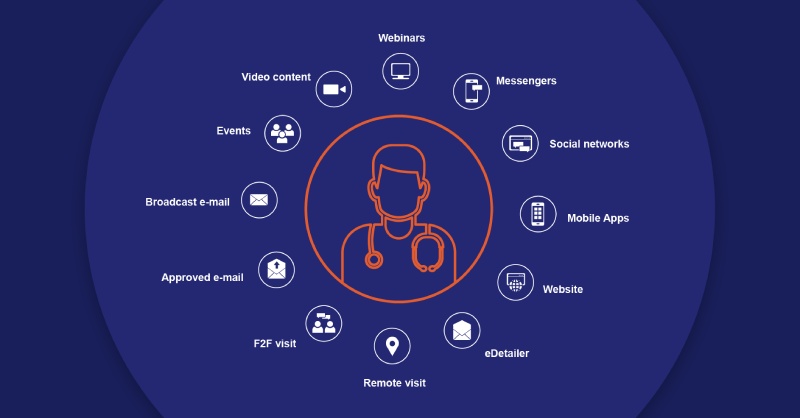Health
Daniel McCormick Shares The Role of Omnichannel Strategies in the Future of Biopharmaceutical Marketing

Omnichannel strategies have shaken the foundations of the biopharmaceutical marketing world. These strategies pave the path to seamless integration and tailored experiences.
In this article, Daniel McCormick shares the critical role of omnichannel in the biopharma industry’s success.
Omnichannel offers untold outreach potential
The ever-changing biopharmaceutical marketing requires more than conventional channels. These strategies have changed the game, allowing biotech and pharma companies to reach their target groups through multiple contact points. This creates a consistent and trustworthy brand experience.
Omnichannel strategies should leverage data-driven insights. With innovative analytics tools, biopharma marketers can better understand provider tendencies and behaviors. This makes it possible to create targeted campaigns and content just for them.
In addition to traditional sales and marketing approaches, these strategies are great for educational initiatives. Companies use social media, websites, podcasts, webinars, etc., to spread essential info about diseases, treatments, and prevention. This not only helps patients, but it also positions biotech and pharma brand organizations as credible knowledge sources.
Cross-channel marketing is recent, but its origins go back to early digital developments. As technology advanced, biopharma identified the need for a holistic approach. Traditional tactics were no longer enough with the growing focus on patient-centricity..
The Concept of Omnichannel Strategies
Biotech and pharmaceutical companies must succeed in their marketing plans by using cross-channel strategies. By joining multiple communication channels, biopharmas create a personalized experience.
Social media, websites, apps, and traditional marketing are a few key touchpoints commonly used. Companies can use them to offer relevant information about their products and services.
Cross-channel strategies gather data and insights on provider behavior. Messages can be tailored to specific healthcare professionals or segments with this data.
Real-time conversations are possible through live chat and interactive content. Companies can address questions, help customers, and build relationships.
A seamless experience is expected from customers across all channels. Companies must use omnichannel strategies to stay ahead and give excellent customer service.
Technology platforms must be invested in for seamless integration. Data analysis and marketing optimization will help maximize returns.
The Importance of Omnichannel Strategies in Biopharmaceutical Marketing
Cross-channel strategies are essential in biopharmaceutical marketing. These strategies ensure the right message is sent through the most effective channels at the optimal time. In the competitive biotech and pharma industry, staying connected with stakeholders is necessary for success.
- Omnichannel strategies give biopharmaceutical companies a better presence across many platforms. They reach a larger audience and have a consistent brand image through social media, websites, email, and print media.
- These strategies give companies more personalized communication with healthcare professionals and patients. Biopharmaceutical companies can form better bonds and gain loyalty by communicating according to individual needs and likes.
- Cross-channel strategies get data analytics for customer behavior. By looking at engagement measurements and user feedback from different channels, companies make wiser decisions on their sales and marketing approaches which ultimately maximizes overall returns on investments.
- Lastly, these strategies make sure information flows well between stakeholders in the biopharmaceutical world. Physicians, pharmacists, researchers, and patients can get up-to-date info about products and medical advances through various channels.
Additionally, exciting content that informs and teaches target audiences is necessary for omnichannel strategies. These are typically articles or videos on disease management or breakthrough treatments. Working with key opinion leaders in the field also helps build trustworthiness.
Using social media properly, biotech and pharma companies communicate two ways with their audience by receiving and providing valuable information. They quickly answer questions and show updates on clinical trials, new drug approvals, and indications.
Interactive websites with user-friendly interfaces help visitors locate relevant data quickly. Adding chatbots can enhance customer experience by providing instantaneous help and support.
Challenges and Barriers to Implementing Omnichannel Strategies in Biotech and Pharma Marketing
Implementing cross-channel strategies in biopharmaceutical marketing comes with its own set of difficulties. Integrating multiple channels without a hitch is one of the main issues. Companies find it hard to sync offline and online efforts, leading to inconsistent customer experiences.
Data privacy is another hurdle. The healthcare sector has strict regulations regarding protecting patients’ information. To remain compliant, biopharmaceutical companies must navigate complex legal frameworks and guarantee the confidentiality of personal health data.
Technology limitations can also impede the successful execution of omnichannel strategies. Setting up digital platforms, databases, and software requires heavy investments in infrastructure and expertise. Making sure all systems work together is a time-consuming process.
To tackle these challenges, biopharmaceutical companies should consider certain measures. One of them is investing in reliable data management systems to make integrating offline and online channels easier and monitor customers’ behavior more efficiently.
Furthermore, utilizing advanced analytics tools provides valuable insights into customers’ preferences and actions. This way, biopharmaceutical companies can personalize their marketing campaigns and send the right messages to audiences.
Finally, ongoing training and upskilling programs are essential for employees to stay up-to-date with emerging technologies and comply with regulations. This will equip them with the skills necessary to use omnichannel platforms proficiently.
Successful Examples of Omnichannel Strategies in Biopharmaceutical Marketing
The biopharmaceutical industry is growing fast. To be successful, omnichannel strategies in marketing are key. These strategies enable companies to connect with their target audience through social media, email, websites, and mobile apps. So customers can have a personalized experience, raising awareness and loyalty.
Social media is an excellent example of a successful cross-channel strategy. Companies use Facebook, Twitter, and Instagram to promote their products and give helpful information. This way, they can be seen as thought leaders and gain trust.
Email marketing is also an essential part of an excellent omnichannel strategy. Companies can send targeted messages directly to the customers’ inboxes. It is a great way to inform people about new products or events.
Websites are also a must-have in an effective cross-channel strategy. Companies must ensure their websites are attractive and user-friendly. They should offer valuable content like product info, research, or educational resources to attract and engage customers.
Finally, mobile apps are essential for a successful omnichannel strategy. Companies must develop a user-friendly app to connect directly with customers and offer features like prescription refill reminders or symptom trackers.
Future Trends and Innovations in Omnichannel Strategies for Biopharmaceutical Marketing
The future of biopharmaceutical marketing lies in cross-channel strategies. With technology and consumer behavior changing, companies must adjust their approach to reach their target. AI and machine learning lets companies analyze data and learn customer preferences. AI personalizes messages and sends them through social media, email, and apps. VR and AR create immersive experiences for customers, which enhances brand awareness. Patient empowerment and engagement are also important, so digital platforms offer educational resources, patient communities, and tools.
84% of physicians believe that digital health tech will significantly affect healthcare delivery in the future. Omnichannel strategies are essential for companies to stay current and connect with their audience.
Digitization of the pharma industry has made cross-channel strategies essential for marketing success. Companies can use these strategies to combine online and offline channels to engage with customers and give them personalized experiences.
Cross-channel strategies help companies to reach their target audience via multiple touchpoints effectively. Websites, social media platforms, mobile apps, and email marketing are just channels companies can utilize to create a unified brand experience.
These strategies also allow for better customer interaction and engagement. Companies can use tailored content to build customer trust and create long-term relationships. Data collected from the interactions can be used to gain insights into customer behavior and preferences.
Furthermore, cross-channel strategies contribute to operational efficiency. By integrating systems and technologies, companies can improve decision-making and coordinate departments.
Expert Commentary: Daniel McCormick’s Insights on the Future of Biotech and Pharma Marketing
Biopharmaceutical marketing is continuously evolving. McCormick’s insights on omnichannel strategies provide valuable information on potential impact.
McCormick suggests that companies use these strategies to reach customers over multiple channels. This increases reach and impact. Additionally, it allows for a smooth, cohesive customer experience.
However, for successful implementation, organizations must shift their mindset. They must abandon traditional biases, break down barriers between departments, and work together.
A biopharmaceutical company is an excellent example of the power of omnichannel strategies. They used social media advertising and personalized emails, increasing brand awareness and sales.
-

 Sports4 weeks ago
Sports4 weeks agoFIFA Club World Cup 2025: Complete List of Qualified Teams and Groups
-

 Sports3 weeks ago
Sports3 weeks agoAl Ahly vs Inter Miami, 2025 FIFA Club World Cup – Preview, Prediction, Predicted Lineups and How to Watch
-
Health1 week ago
Back to Roots: Ayurveda Offers Natural Cure for Common Hair Woes
-

 Tech2 weeks ago
Tech2 weeks agoFrom Soil to Silicon: The Rise of Agriculture AI and Drone Innovations in 2025
-

 Sports3 weeks ago
Sports3 weeks agoFIVB Men’s Volleyball Nations League 2025: Full Schedule, Fixtures, Format, Teams, Pools and How to Watch
-

 Science4 weeks ago
Science4 weeks agoEverything You Need to Know about Skywatching in June 2025: Full Moon, New Moon, Arietid Meteors, and Planetary Marvels
-

 Startup3 weeks ago
Startup3 weeks agoHow Instagram Is Driving Global Social Media Marketing Trends
-

 Television4 weeks ago
Television4 weeks agoTribeca Festival 2025: Date, Time, Lineups, Performances, Tickets and How to Watch













